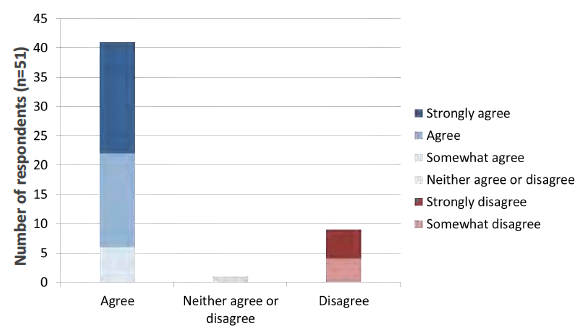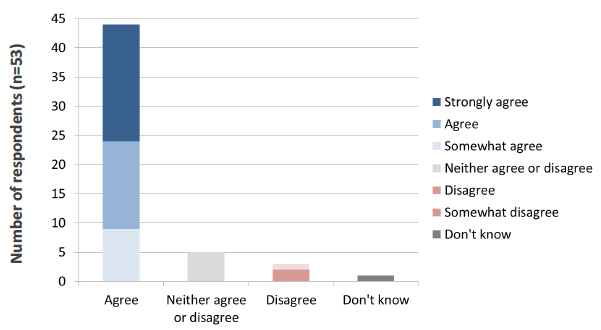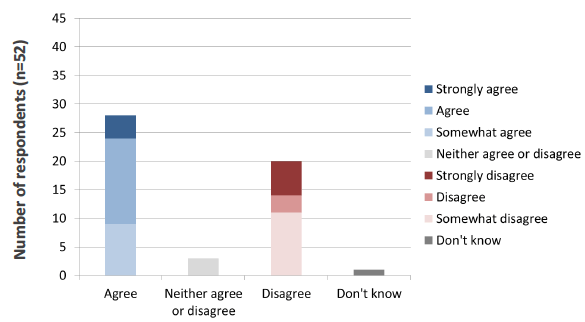New Psychoactive substances (NPS): results of a questionnaire on the definition of NPS, proposals to establish a forensic centre for excellence, and improving data collection and information sharing
Results of a questionnaire on the definition of new psychoactive substances, proposals to establish a forensic centre for excellence, and improving data collection and information sharing
3. Defining New or Novel Psychoactive Substances
3.1 High level definition of NPS
The questionnaire proposed that the legal definition of psychoactive substances set out in the Psychoactive Substances Act should be adopted by a wide range of stakeholders at a national and local level in Scotland. The Act defines psychoactive substances as:
"Any substance which is capable of producing a psychoactive effect in a person who consumes it, and is not an exempted substance [i.e. alcohol, tobacco, medicines and controlled drugs, caffeine and foodstuffs such as nutmeg and chocolate]…A substance produces a psychoactive effect in a person if, by stimulating or depressing the person's central nervous system, it affects the person's mental functioning or emotional state…A person consumes a substance if the person causes or allows the substance, or fumes given off by the substance, to enter the person's body in any way[5]."
Forty one respondents agreed with this proposal, nine disagreed and one respondent neither agreed or disagreed (Figure 1).

Figure 1: A wide range of stakeholders should adopt the legal definition as set out in the Psychoactive Substances Act[6]
Thirty-seven respondents provided more detail or alternative suggestions to the legal definition in the follow up free text question. The key themes from these responses are presented below.
Support for the proposed definition
Amongst those who agreed, a key theme to emerge was the need for consistency. Fifteen respondents emphasised the importance of adopting a consistent definition that could be used by a range of stakeholders because it "allows standardisation of reporting and information collection across Scotland" (third sector organisation), and ensures that "every stakeholder talks about the same thing" (academic organisation).
Concerns raised about the proposed definition
However, concerns were also raised about the specific definition proposed under the Psychoactive Substances Act. In total, five individuals strongly disagreed that the definition proposed should be adopted more widely, arguing that the limitations were too significant:
"The definition set out in the Psychoactive Substances Bill is far too wide ranging and therefore not fit for purpose" (individual).
Four others 'somewhat disagreed' on the basis that it was impractical to expect different stakeholders to adopt a single definition:
"Services other than law enforcement require an alternative definition that provides scope to examine harm" (individual).
Other concerns were raised about a lack of clarity about which substances would be exempt, the breadth of the definition as currently worded, absence of the concept of harm and concerns about implementation.
Alternative definitions
Four respondents stated they would prefer an alternative definition, based on existing definitions used by organisations such as the Advisory Council on the Misuse of Drugs (ACMD), the European Monitoring Centre for Drugs and Drug Addiction (EMCDDA), or the United Nations Office on Drugs and Crime (UNODC). It was suggested by one respondent that at the very least the definition used would need to be capable of mapping against these other definitions.
Overall however, there was recognition that any definition would have limitations, given the complexity of the issue and the range of substances to be captured. For the majority of respondents therefore, it seemed that concerns about the specific definition were outweighed by the benefits of having a consistent definition used by a range of stakeholders:
"It is difficult to think of a definition where there would not be some possibility of ambiguity, and so it is with this, but it is better than what we have used in the past" (individual).
3.2 Categorising NPS according to their effects
In addition to the high level definition, the questionnaire proposed that stakeholders should categorise NPS based on their intended effects, in line with the Drugs Wheel Model[7]. Using this model, NPS would be categorised as follows:
- Opioids
- Stimulants
- Empathogens
- Psychedelics
- Dissociatives
- Other
- Depressants
- Unknown
- Cannabinoids
The vast majority (44 respondents) agreed that stakeholders should categorise NPS based on their intended effects (Figure 2).

Figure 2: Stakeholders should categorise NPS based on their intended effect(s)
However, there was less agreement about whether these categories could be applied accurately by people who are not experts in NPS. Although 28 respondents agreed that the categories could be accurately applied, 20 disagreed (six strongly) (Figure 3).

Figure 3: The categories outlined in proposal two could be applied accurately by people who are not experts in NPS
Suggestions for changes to the proposed categories were provided by 21 respondents. Thirty-six respondents also provided details about additional information that would be needed for the categories to be applied accurately. Taken together these responses highlighted a number of key themes.
Support for categorising NPS according to effect
Ten respondents explicitly supported the use of the model. It was described as well-established and understood, and seen as a useful tool to allay fears of lack of knowledge around chemical make-up of substances.
The need for guidance, awareness raising and training
However, the need for clear guidance on the use of the model, and in particular on how to categorise different substances was emphasised by 21 respondents. It was suggested that examples of the most common drugs should be given, as well as descriptions of intended effects, e.g. 'loved up, excited' with empathogens. The fact that the proposed model mixes both 'effects' and 'type of drug', and that some NPS would fit under more than one category within the model was also raised as a potential issue:
"We think that it is good to categorise by effects, however the Drugs Wheel has its limitations. Can drugs be under more than one heading? Where do synthetic cannabinoids go, for example, they seem to have several different effects?" (academic organisation)
It was suggested that this was further complicated by the lack of homogeneity within NPS products, because a named product would not necessarily behave consistently or result in similar effects. One respondent suggested that these issues could be addressed by highlighting that a substance could potentially fit in more than one category.
In addition to comments about the need for clear guidance, seven respondents suggested that some form of training or basic awareness raising would be required in order to enable people to apply the categories accurately. One respondent also mentioned that there would need to be resources made available to stakeholders if they were to be expected to categorise NPS appropriately.
The role of experts in assigning substances to categories
Seven respondents expressed the view that only experts, or those with experience of dealing with individuals under the effect of these drugs, would be able to apply the categories. This was felt to be the case particularly for substances that are seen for the first time and not already categorised. One respondent argued that substances should only be categorised after being subjected to forensic chemical analysis.
Actual versus intended effect
In addition to these comments three respondents suggested that categories may need to be based on actual effect, rather than intended effect:
"Given the uncertainties of what has been consumed (both by services and by users) this may need to be actual effect" (individual).
Three respondents also suggested reducing the number of categories, in order to minimise confusion.
3.3 Other issues relating to the definition of NPS
Other issues relating to the definition of NPS that were raised by respondents included the need for any definition to enable data on harms to be captured. Two respondents raised the issue of 'NPS' that have already been controlled (for example under the Misuse of Drugs Act 1971 or the Medicines Act 1968). It was argued that substances such as gabapentin, PMA and mephedrone might create increasing problems, but they would not be classed as an NPS under the Psychoactive Substances Act.
One respondent also queried whether following the introduction of the Psychoactive Substances Act, it would still be necessary to distinguish between NPS and other controlled drugs.
Contact
Email: Isla Wallace
There is a problem
Thanks for your feedback